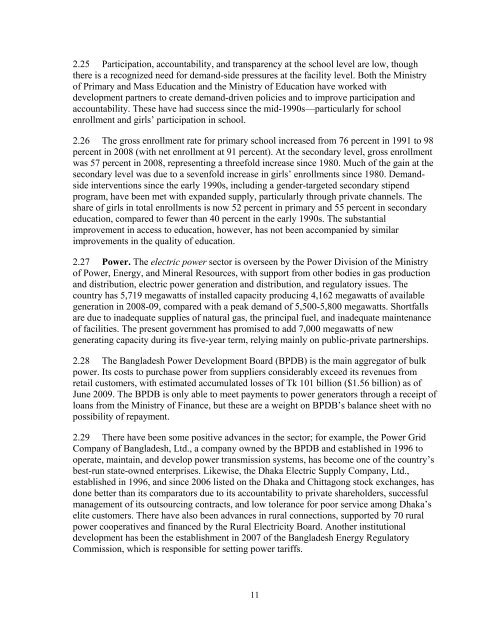Bangladesh - Independent Evaluation Group - World Bank
Bangladesh - Independent Evaluation Group - World Bank
Bangladesh - Independent Evaluation Group - World Bank
You also want an ePaper? Increase the reach of your titles
YUMPU automatically turns print PDFs into web optimized ePapers that Google loves.
2.25 Participation, accountability, and transparency at the school level are low, though<br />
there is a recognized need for demand-side pressures at the facility level. Both the Ministry<br />
of Primary and Mass Education and the Ministry of Education have worked with<br />
development partners to create demand-driven policies and to improve participation and<br />
accountability. These have had success since the mid-1990s—particularly for school<br />
enrollment and girls’ participation in school.<br />
2.26 The gross enrollment rate for primary school increased from 76 percent in 1991 to 98<br />
percent in 2008 (with net enrollment at 91 percent). At the secondary level, gross enrollment<br />
was 57 percent in 2008, representing a threefold increase since 1980. Much of the gain at the<br />
secondary level was due to a sevenfold increase in girls’ enrollments since 1980. Demandside<br />
interventions since the early 1990s, including a gender-targeted secondary stipend<br />
program, have been met with expanded supply, particularly through private channels. The<br />
share of girls in total enrollments is now 52 percent in primary and 55 percent in secondary<br />
education, compared to fewer than 40 percent in the early 1990s. The substantial<br />
improvement in access to education, however, has not been accompanied by similar<br />
improvements in the quality of education.<br />
2.27 Power. The electric power sector is overseen by the Power Division of the Ministry<br />
of Power, Energy, and Mineral Resources, with support from other bodies in gas production<br />
and distribution, electric power generation and distribution, and regulatory issues. The<br />
country has 5,719 megawatts of installed capacity producing 4,162 megawatts of available<br />
generation in 2008-09, compared with a peak demand of 5,500-5,800 megawatts. Shortfalls<br />
are due to inadequate supplies of natural gas, the principal fuel, and inadequate maintenance<br />
of facilities. The present government has promised to add 7,000 megawatts of new<br />
generating capacity during its five-year term, relying mainly on public-private partnerships.<br />
2.28 The <strong>Bangladesh</strong> Power Development Board (BPDB) is the main aggregator of bulk<br />
power. Its costs to purchase power from suppliers considerably exceed its revenues from<br />
retail customers, with estimated accumulated losses of Tk 101 billion ($1.56 billion) as of<br />
June 2009. The BPDB is only able to meet payments to power generators through a receipt of<br />
loans from the Ministry of Finance, but these are a weight on BPDB’s balance sheet with no<br />
possibility of repayment.<br />
2.29 There have been some positive advances in the sector; for example, the Power Grid<br />
Company of <strong>Bangladesh</strong>, Ltd., a company owned by the BPDB and established in 1996 to<br />
operate, maintain, and develop power transmission systems, has become one of the country’s<br />
best-run state-owned enterprises. Likewise, the Dhaka Electric Supply Company, Ltd.,<br />
established in 1996, and since 2006 listed on the Dhaka and Chittagong stock exchanges, has<br />
done better than its comparators due to its accountability to private shareholders, successful<br />
management of its outsourcing contracts, and low tolerance for poor service among Dhaka’s<br />
elite customers. There have also been advances in rural connections, supported by 70 rural<br />
power cooperatives and financed by the Rural Electricity Board. Another institutional<br />
development has been the establishment in 2007 of the <strong>Bangladesh</strong> Energy Regulatory<br />
Commission, which is responsible for setting power tariffs.<br />
11

















